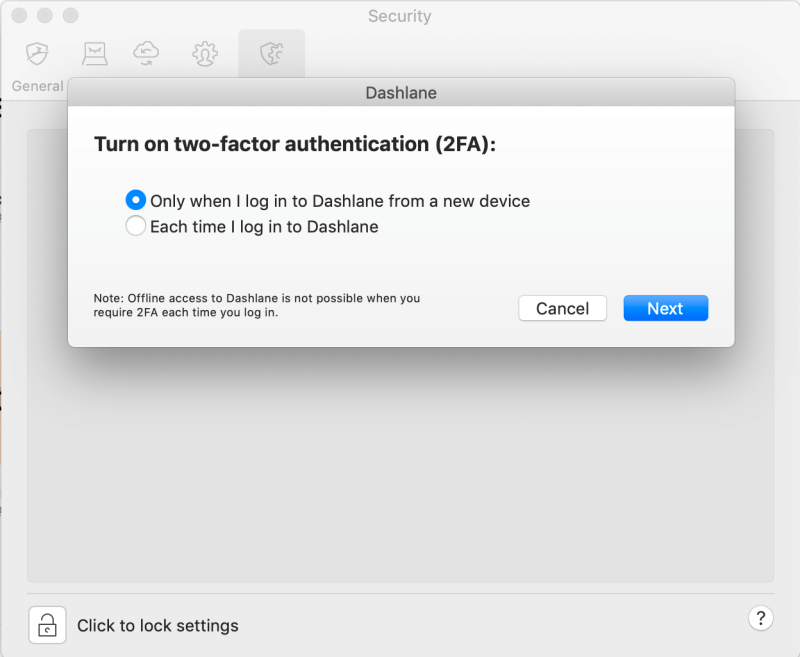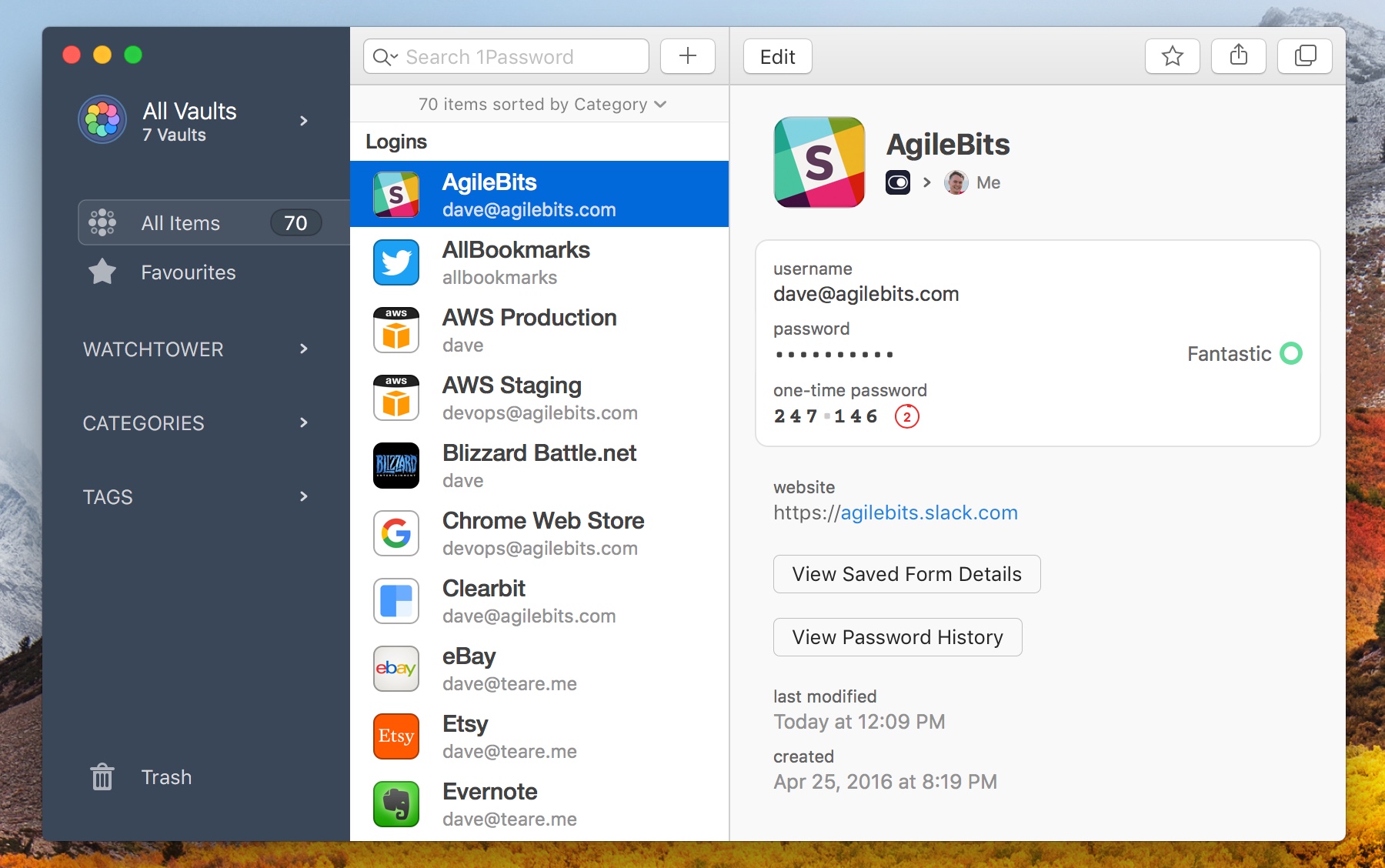| Developer(s) | AgileBits Inc. |
|---|---|
| Initial release | June 18, 2006[1] |
| Stable release |
|
| Platform | Android, Chrome OS, iOS, macOS, Windows,[5] and browsers Firefox, Google Chrome, Opera, Safari[6] |
| Type | Password manager |
| License | Trialware[7][8] |
| Website | 1password.com |
1Password is a password manager developed by AgileBits Inc. It provides a place for users to store various passwords, software licenses, and other sensitive information in a virtual vault that is locked with a PBKDF2-guarded master password.[9][10] By default, this encrypted vault is stored on the company's servers for a monthly fee.[11]
Password file syncing[edit]
1Password can be configured so that files are synchronized through Dropbox (all platforms), local Wi-Fi, and iCloud, and through 1Password.com, a paid subscription-based server sync service maintained by the developers. Local Wi-Fi and iCloud sync are only available on iOS and macOS.[12][13][14]
When you’re on a log in page in Safari, just tap the share button, then 1Password, then select the login information to use. You may have to manually enable this button first by tapping the share. It works offline, that is, you have to shutdown your computer and boot off a CD or USB disk to do the password reset. Will detect and offer to unlock locked or disabled out user accounts! There is also a registry editor and other registry utilities that works under linux/unix, and can be used for other things than password editing. A password like '123456' may be easy to remember, but it's also equally easy to guess or hack. Use one of these top free password managers to help you create and manage strong, unique passwords.
In 2017, the Travel Mode feature was introduced for subscribers of 1Password.com, which enables omission of password entries not tagged as safe for travel from the local storage on a particular device, reducing the impact of being obliged by officials to unlock access at country border crossings.[15]

Browser extensions[edit]
1Password integrates with desktop web browsers including Safari, Chrome, Firefox, Edge, and Opera.[16] The extension can remember logins for websites, fill in website logins automatically, and generate random passwords for new websites.[17]
To use browser extensions, the user must have administrative rights on the computer where the browser is installed. This has been an issue with users on a PC assigned by a workplace without admin rights. To address this issue, 1Password offers plans for a monthly subscription fee aimed at businesses that allows web access to their usernames and passwords which can be copied and pasted into login screens.[18] Plans for family and individual use are also available.[19]

1Password also offers a standalone extension called 1Password X, available for Firefox, Chrome, and Opera.[20] 1Password X is designed to work without a companion desktop app, but a 1Password.com subscription is required.[21]
On the mobile side, 1Password offers integration with browsers and apps on iOS and Android devices using various methods. More convenient methods of filling and saving login information are provided in iOS 12[22] and Android Oreo (and later),[23] respectively.
History[edit]
In a 2017 Consumer Reports article, Dan Guido, the CEO of Trail of Bits, listed 1Password as a popular password manager (alongside Dashlane, KeePass, and LastPass), with the choice among them mostly up to personal preferences.[11]
Before 1Password 7, and the move to a purely subscription-based service in 2018, 1Password could be set up to only store password files locally, and not sync with remote servers, after purchasing a software license ($64.99 in 2018[24]).[11] As of Dec 2019, Mac users can still buy a perpetual licence of 1Password 7 from within the app.[25] Apple's browser Safari v13 makes the installation of the 1Password extension v6 impossible, thus forcing users to upgrade to 1Password v7.[26]
On November 14, 2019, 1Password announced a partnership with venture capital firm Accel, which invested $200 million in a Series A funding round and obtained a minority stake in the company.[27] It was the first outside funding in 1Password's history, and the largest single investment Accel had made to date.[28][29]
See also[edit]
References[edit]
- ^'1Password 1.0.0 Release'. Archived from the original on 2015-02-15. Retrieved 2015-02-14.
- ^'1Password for Windows Release Notes'. Retrieved 7 May 2020.
- ^'1Password for Mac Release Notes'. Retrieved 7 May 2020.
- ^'1Password for Android Release Notes'. Retrieved 7 May 2020.
- ^'1Password X brings me closer to using a Chromebook full-time'. Android Central. 23 November 2017. Retrieved 29 June 2018.CS1 maint: discouraged parameter (link)
- ^'Download 1Password for your browser'. Retrieved 19 July 2019.CS1 maint: discouraged parameter (link)
- ^'Pricing & free trial'. Retrieved 19 July 2019.CS1 maint: discouraged parameter (link)
- ^'1Password Restores Free-to-Use Local Vault Option in Latest Version of iOS App'. Retrieved 19 July 2019.CS1 maint: discouraged parameter (link)
- ^Haslam, Oliver (28 August 2018). 'Are password managers safe?'. 1Password Blog. Retrieved 2 January 2019.CS1 maint: discouraged parameter (link)
- ^Goldberg, Jeffrey (16 March 2013). '1Password hashcat strong master passwords'. 1Password Blog. Retrieved 2 January 2019.CS1 maint: discouraged parameter (link)
- ^ abcChaikivsky, Andrew (2017-02-07). 'Everything You Need to Know About Password Managers'. Consumer Reports. Retrieved 2019-02-23.
- ^Fleishman, Glenn (2018-06-11). '1Password 7 for Mac review: Password manager with small improvements that add up'. Macworld. Retrieved 2019-02-23.
- ^Myers, Robert McGinley (8 August 2017). 'The Best Password App and Manager (and why you need one)'. The Sweet Setup. Retrieved 1 November 2018.CS1 maint: discouraged parameter (link)
- ^Tedeschi, Bob (2010-11-03). 'Apps to Manage Your Cluster of Passwords'. The New York Times. ISSN0362-4331. Retrieved 2019-02-23.
- ^Kastrenakes, Jacob (2017-05-23). '1Password adds a 'travel mode' to keep your passwords safe at the border'. The Verge. Retrieved 2019-02-23.
- ^Rubenking, Neil J. (14 June 2018). 'AgileBits 1Password - Review 2018'. PCMag UK. Retrieved 1 November 2018.
- ^'Use the 1Password extension to save and fill passwords on your Mac or Windows PC'. 1Password. Retrieved 1 November 2018.CS1 maint: discouraged parameter (link)
- ^'The most secure password manager for teams'. 1Password. Retrieved 20 June 2018.
- ^'Password manager to keep your family safe'. 1Password. Retrieved 20 June 2018.
- ^Wagenseil, Paul (2019-02-15). 'Best Password Managers 2019'. Tom's Guide. Retrieved 2019-02-23.
- ^Teare, Dave (13 November 2017). '1Password X: A look at the future of 1Password in the browser'. 1Password Blog. Retrieved 30 December 2018.
- ^Cao, Peter (2018-08-21). 'Hands-on with 1Password and iOS 12's Password AutoFill feature'. 9to5Mac. Retrieved 2019-02-23.
- ^El Khoury, Rita (2017-03-25). 'AgileBits shows us how Android O's autofill API works with a 1Password demo'. Android Police. Retrieved 2019-02-23.
- ^Riley, Sean (2018-11-16). '1Password Review: For the Apple Faithful'. Tom's Guide. Retrieved 2019-02-23.
- ^Riley, Sean (2018-11-16). '1Password Review: For the Apple Faithful'. Tom's Guide. Retrieved 2019-12-12.
- ^'Safari 13'. TidBITS. Retrieved 12 December 2019.CS1 maint: discouraged parameter (link)
- ^'1Password partners with Accel for continued growth | 1Password'. 1Password Blog. 2019-11-14. Retrieved 2019-11-14.
- ^'In Its First Funding In 14 Years, Toronto's 1Password Raises $200M Series A Led By Accel'. Crunchbase News. 2019-11-14. Retrieved 2019-11-14.
- ^'Fourteen years after launching, 1Password takes a $200M Series A'. TechCrunch. Retrieved 2019-11-14.
External links[edit]
Create a backup
Open 1Password and choose File > Backup.
To find where the backup files are kept, choose 1Password > Preferences > Backups and click Show Files.
Restore a backup
Open 1Password and choose File > Restore. Select the backup you want to restore and click Restore.

Create a backup
Open and unlock 1Password on your iOS device, then tap Settings > Advanced > Create Backup.
If you’re using macOS Catalina or later
Connect your iOS device to your computer using the USB cable that came with your device.
In Finder, click your device in the sidebar. Get help if you can’t find it.
If it’s the first time you’ve connected this device, click Trust on your Mac. Then unlock your iOS device, tap Trust, and enter your passcode.
Click the Files tab, then click next to 1Password.
Drag the Backups folder to your Desktop or other folder on your Mac.
If you’re using an earlier version of macOS or a Windows PC
- Open iTunes on your Mac or PC.
- Connect your iOS device to your computer using the USB cable that came with your device. If you see “Trust This Computer?” on your iOS device, tap Trust.
- Click your device in iTunes. Get help if you can’t find it.
- Click File Sharing in the sidebar, then select 1Password in the list of apps.
- Select the Backups folder from the 1Password Documents list and click “Save”.
- Find the folder on your computer to which you want to copy the files and click “Save” or “Select folder”.
Restore a backup
If you’re using macOS Catalina or later
Connect your iOS device to your computer using the USB cable that came with your device.
In Finder, click your device in the sidebar. Get help if you can’t find it.
If it’s the first time you’ve connected this device, click Trust on your Mac. Then unlock your iOS device, tap Trust, and enter your passcode.
Click the Files tab, then click next to 1Password.
Drag a Backups folder or .1p4_zip file from a folder or window on your Mac onto the 1Password icon.
Click the Sync button to copy the files to your iOS device.
Open and unlock 1Password on your iOS device, then tap Settings > Advanced > Restore Backup and follow the onscreen instructions.
If you’re using an earlier version of macOS or a Windows PC
Open iTunes on your Mac or PC.
Connect your iOS device to your computer using the USB cable that came with your device. If you see “Trust This Computer?” on your iOS device, tap Trust.
Click your device in iTunes. Get help if you can’t find it.
Click File Sharing in the sidebar, then select 1Password in the list of apps.
Drag a Backups folder or .1p4_zip file from a folder or window on your computer onto the 1Password Documents list to copy it to your device.
You can also click Add in the 1Password Documents list in iTunes, find a Backups folder you want to copy from your computer, and then click Add.
If iTunes asks you to replace the existing Backups folder, click Replace.
Open and unlock 1Password on your iOS device, then tap Settings > Advanced > Restore Backup and follow the onscreen instructions.
Restore a backup
- Create a folder called
1Password.opvaulton your desktop:- Right-click your desktop and choose New > Folder.
- Name the folder
1Password.opvault.
- Open Start, type
%LOCALAPPDATA%1PasswordBackupsto search, then press Enter. You’ll see a list of folders, one for each vault 1Password has backed up. - Open the folder for the vault you want to restore. You’ll see a list of .zip files with names corresponding to the date and time of each backup.
- Right-click the .zip file you want to restore and choose Extract All.
- Click Browse, choose the
1Password.opvaultfolder on your desktop, and click Select Folder. - Click Extract. If you see “There is already a file with the same name as the folder name you specified”, contact 1Password Support.
1password Offline Installer
To add the vault to your existing 1Password data, open 1Password and choose 1Password > “Open vault on this PC”.

To replace all your existing 1Password data:
Open 1Password. You don’t need to enter your Master Password.
- Click the Startmenu.
- Click the 1Password icon .
Choose Help > Troubleshooting > Reset All 1Password Data and follow the onscreen instructions.
Open 1Password and choose “Sync using folder” on the welcome screen.
1password Offline Mode
Exporting your data to an OPVault folder requires Dropbox, WLAN Server, or local folder sync.
1password Standalone
- Open and unlock 1Password.
- Tap Settings > Advanced > “Export primary vault”.
1password Offline
Your 1Password data will be saved to a folder named 1PasswordExports in local storage on your device.
